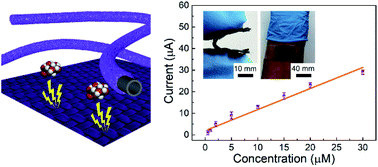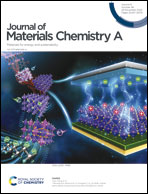Oxide nanomembrane induced assembly of a functional smart fiber composite with nanoporosity for an ultra-sensitive flexible glucose sensor†
Abstract
Smart cloth, as well as smart fibers, exhibits promising prospects in wearable electronics applications. However, very few kinds of smart fibers can be applied in the biomedical-related area, and the high cost and the poor adhesion between the functional layer and textile substrate remain challenging. Here, we present an efficient strategy utilizing atomic layer deposition pretreatment to induce the growth of hydroxy double salt (HDS) nanosheets on carbon fibers, and the HDS nanosheets are then chemically converted into a zeolitic imidazolate framework-67 layer, which closely attaches to the carbon fibers, forming composite Co-containing porous smart fibers (Co-PSF). On these smart fibers, a three-dimensional (3D) functional film is assembled and intimately adheres to the surface of the fibers, forming a hierarchical nanostructure with an enhanced surface area. The corresponding increased exposure of active sites and the improved electron transfer in the composite lead to improved efficiency of the electrochemical reaction and result in excellent glucose sensing in terms of good anti-interference ability, fast response, and an ultrahigh sensitivity of 4835 μA mM−1 cm−2. Furthermore, the smart textile derived from Co-PSF shows good flexibility and stable electrochemical performance under 100 cycles of 180° bending.



 Please wait while we load your content...
Please wait while we load your content...